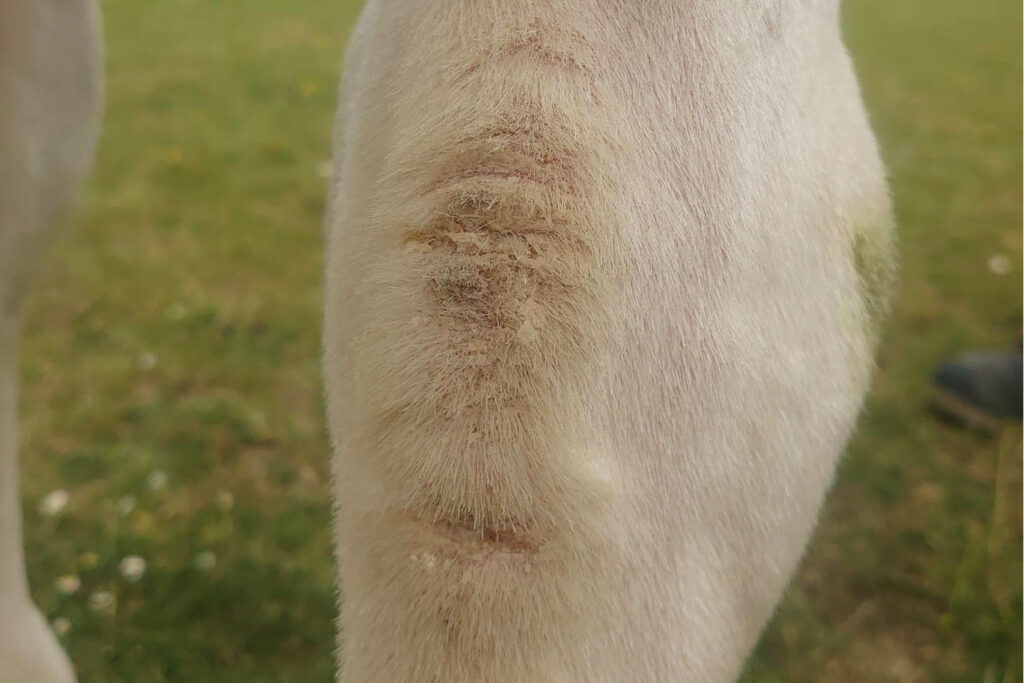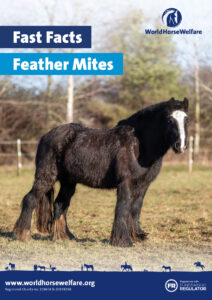Whilst feathery legs can be quite spectacular – particularly when seen in full flight! – they can present their own challenges to those caring for horses with that amount of hair. One of these challenges is infestation with heel mites. These mites cause a very itchy condition called chorioptic mange or, put more simply, ‘itchy heels’. Affected horses often stamp, chew their lower legs or rub on any object they can access to try to relieve the itching.

Can you see if a horse has mites?
Mange mites aren’t visible to the naked eye. They are found in the feathers, making the horse incredibly itchy and causing scabs to form. The mites live on the surface of the skin and feed on dead skin flakes. Thick feathers provide an ideal environment for them, as the dense hair traps dirt and dead skin cells, as well as protecting the mites from any extreme temperatures.
How do you treat mites in horses?
Treatment can be tricky, as mites are often widespread in the horse’s environment – and other horses in the herd or on the yard may have mites even though they aren’t showing any symptoms. It is important to watch out for early signs of the problem as this makes treatment more likely to be successful. If there are groups of horses housed together it might be necessary to treat all horses who have contact with the one known to have mites, to prevent the problem recurring.
It is worth seeking veterinary advice when the symptoms are first seen as early treatment is important.
- If caught soon enough, it may be possible to avoid clipping the horse’s legs but once the mites have established, removing the feathers to allow treatments to be applied in direct contact to the skin may be necessary.
- The next step is usually to wash the horse’s legs thoroughly with an anti-parasitic shampoo.
- A specialised shampoo which gently removes any crusts/dead skin is really helpful, as it allows active ingredients to get right down to the skin.
- It’s important to repeat this around 10-14 days later as this will catch any mites which have hatched since the first application.
- Topical ivermectin treatments may also be available from your vet.
Currently there are no veterinary products licensed in the UK to treat mites in horses, but vets often recommend a topical antiparasitic application such as Frontline or a product called Dectomax (licenced for sheep and cattle) which has proved very effective in reducing the number of mites across the horse’s whole body. If Dectomax is chosen as a treatment option, your horse will probably need two injections at a three-week interval to begin with, followed by further injections at three to six-month intervals as determined by your vet.
If your horse is stabled, it’s important to keep the stable environment very clean. Make sure all bedding is removed and the stable thoroughly disinfected at each stage of the treatment – otherwise your horse could easily pick mites up from their surroundings again. Straw and deep litter beds may not be suitable so it might be best to consider using shavings and/or rubber matting.
Fast Facts guide to Feather mites

This Fast Facts guide includes:
- Clinical signs and diagnosis
- Treatment of mites
- Preventative measures against mites
Popular advice in Health

Sweet itch
Sweet itch is one of the most common allergic skin diseases affecting horses in the UK - learn how to prevent and manage it.
Other advice categories
All webinar categories:
Call our Advice Line
+44 (0)1953 497 238Not found the advice or answer you were looking for here? Then our Advice Line is available during office hours, or you can email us on education@worldhorsewelfare.org to let us know what topics you were looking for.



